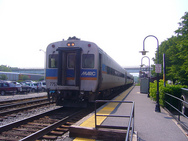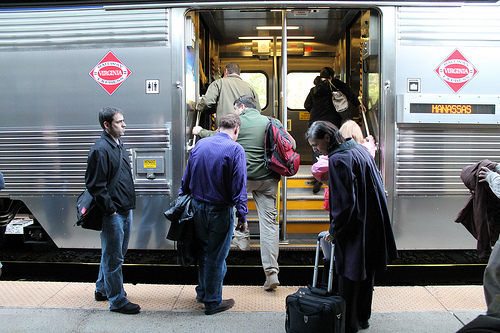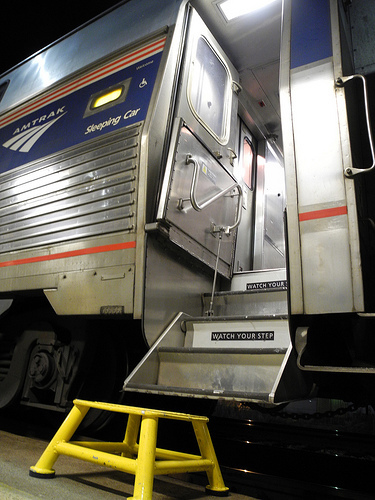Through-running isn’t so easy for MARC and VRE, part 1

Photo by phrenologist on Flickr.
It seems logical: MARC’s trains all end at Union Station in the south. VRE’s trains all end at Union Station in the north. Union Station has capacity constraints. Why not create one regional rail operator, where all trains continue through the core and out the other end?
This idea, often called through-running, comes up often. Unfortunately, several hurdles make it much more complicated and expensive than one would think at first glance. The platform heights and train systems are incompatible between MARC and VRE, the tracks at Union Station don’t line up properly, and VRE does not right now have the track space.
The most technically difficult problem to resolve is platform height. MARC uses a combination of high platforms and low platforms, with their cars optimized for high platforms. VRE runs cars that can only use low platforms.
Unfortunately, just replacing all of the railcars in one of the two fleets would simply create another problem: inefficient boarding.
Why does VRE use low platforms?
VRE trains operate on two lines south of Washington that are owned by freight railroads. Because the freight railroads (CSX for the Fredericksburg Line and Norfolk Southern (NS) for the Manassas Line) own the tracks, they get to have a say about what types of platforms can be built. And that means low platforms.
Low platforms are typically placed at about the height of the top of the rail. The reason freight railroads want these types of platforms is because freight cars are wider than passenger cars, and high platforms could intrude into the dynamic envelope of a freight train.
As long as VRE operates on rail lines that are predominately freight railroad corridors, it will be stuck with using low platforms. There’s not really anything wrong with that, except that in this case, it’s an obstacle to through-running.
Railcar design matters
For passenger railroads using low platforms, there are 3 basic types of double-decker cars in use. Two of these offer access to the lower level with just one or two steps up from the platform, and can therefore be fairly efficient in boarding.
They’re also much easier for mobility-impaired riders to board. Platforms can be designed to have a small area at the height of the floor, set back from the tracks. When necessary, a bridge plate is used for wheelchairs.


Left: A bi-level commuter coach with low-level boarding in Minneapolis. Photo by the author.
Right: An Amtrak California double-decker car. Photo by Wayan Vota.
Many cities outside of the Northeast use these cars, with the Amtrak California cars operating in Southern California and the Bay Area. The bi-levels are used in places like Seattle, San Francisco, and Miami.
VRE uses gallery cars, the third type. These cars have 2 levels, but passengers must climb 4 steps to board even just to the lower level. But the stairs are fairly wide and are not as steep as the stepwells on high-platform equipment. Gallery cars cannot use high platforms at all.
In order to speed boarding, VRE could easily move toward either the bi-level or Amtrak model. In fact, for a while, VRE was using a set of bi-levels leased from Seattle’s Sound Transit.
What’s wrong with using high-platform equipment on VRE?
If MARC can use high-platform equipment, why can’t VRE? Well, VRE could use high-platform equipment, and in fact, they have done so in the past. But using high-platform equipment at low platform stops is inherently less efficient.
Using high-platform equipment means that conductors have to manually open each door (instead of automatic doors in the whole train) at low-platform stops. That generally means that only one or two doors aboard the train can open, as is the case with the MARC stops at places like College Park and West Baltimore.
Additionally, boarding a high-platform train from a low platform means ascending a narrow, steep staircase. That means it takes longer for passengers to board and alight.
What about MARC?
Like VRE, MARC runs 2 of its lines on tracks that are primarily used for freight. For that reason, most of the stations on the Camden Line and all of the stations on the Brunswick Line have low platforms.
But for MTA, the agency that operates the MARC commuter trains, it makes a lot of sense to have a fairly standard fleet because it can then move its cars between lines as necessary.
MARC’s busiest line, the Penn Line, operates on Amtrak’s Northeast Corridor, and most of those stops have high platforms. This is due to the fact that Amtrak (and the previous operators) have long used single-level railcars for their services. For single-level cars, high platforms are the only way to have step-free access to trains.
On the Penn Line, south of Baltimore, only West Baltimore, Halethorpe, and some of the platforms at Union Station are still low. Halethorpe is currently undergoing conversion to high platforms, and Amtrak recently announced plans to convert most of the platforms at Union Station to high platforms.
On the Camden Line, Greenbelt and Camden stations have high platforms. The other stations all have low platforms. On the Brunswick Line, all stations have low platforms.
What does this mean for through-running?
The practical effect of this arrangement is that through-running trains from either MARC or VRE will be difficult.
The current fleet of VRE trains are not able to use high-platform stations, which means they can’t operate on the Penn Line to Baltimore. VRE trains also can’t operate on the Camden Line, because they would be unable to serve the terminal station in Baltimore, since it only has high platforms. And that leaves the Brunswick Line as the only viable line they could operate on.
But running VRE trains on the Brunswick Line presents some other challenges: the way tracks are laid out in DC. Tomorrow, we’ll look at those issues.


